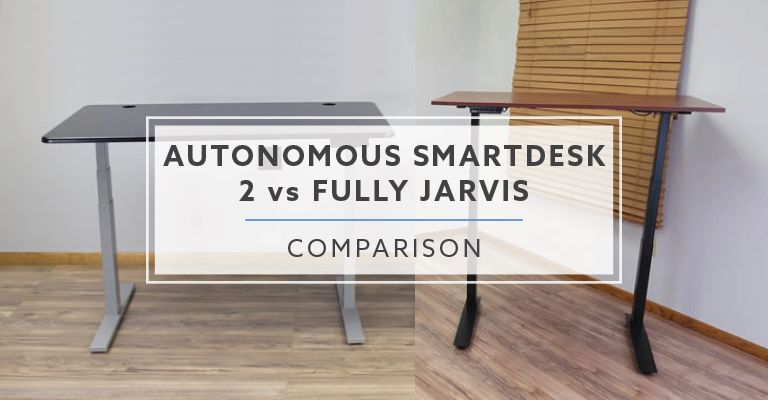Today we are going to be taking a closer look at two electric standing desks, the Autonomous Desk and Jarvis Desk. Both of these models have raised the ranks in popularity over the past handful of years. While each desk looks similar, they are actually quite a bit different. Let’s take a closer look at how they both compare.
Full Disclaimer: We are an office furniture dealer and sell some of the adjustable height tables we review. To learn more about the products we sell, our review process and why you can trust us, please visit: Why we’re different. Who is BTOD.com and The Breakroom Blog?
Autonomous SmartDesk 2 VS. Fully Jarvis
– OEM Manufacturer
– Where Are Components Made?
– Pricing
– Assembly
– Specs / Features
– Stability
– Electronics
– Weight Capacity Testing
– Motors / Gears / Glides
– Frame and Feet
– How They Operate
– Return Policy and Warranty
– Bottom Line
OEM Manufacturer
When the Autonomous Desk first launched in 2015, they actually used the same OEM as Jarvis. Since their first version of the Business Edition desk, Autonomous has switched to Aoke Furniture to produce their frames. Aoke has been in business since 2012 and is based in the harbor town of Ningbo. Aoke currently manufacturers their frame components while using TiMotion for all of their electronic components.
The Jarvis Desk is currently manufactured by JieCang Linear Technology. This is the same company they have worked with since the launch of their brand in 2013. They have been producing linear actuators for hospital beds and accessories since early 2000 and in 2011 they saw an opportunity to produce adjustable bases. Using their linear actuator technology within metal desk frames, the JieCang standing desk was born. They are currently the leading Chinese manufacturer of electric standing desks.
Where are the components made?
| Autonomous SmartDesk 2 |
Jarvis Desk | |
| Frame | China | China |
| Electronics | China | China |
| Gears | China | China |
| Assembly | China | China |
2024 Pricing
| Autonomous Desk (30” x 53”) | Jarvis Desk (30” x 60”) | |
| Frame Only (expandable) | $599 | n/a |
| Laminate | n/a | $1025 |
| Bamboo | $749 | $1075 |
| Powder Coated | $599 | n/a |
Assembly
Overall, the assembly for each desk is fairly easy, with similar pain points during the assembly process. Each desk will take most users between 30 and 90 minutes to complete. Autonomous Desk has done a nice job separating their hardware into individually labeled bags. Because there are quite a few screws this helps to locate each more efficiently. Because JieCang has been producing this frame style longer, it does appear that Aoke has borrowed some design ideas. This was especially true with the upper support frame, as the assembly process was exactly the same between Autonomous and Jarvis.
Both brands have elected to use rubber dampeners to reduce vibrations between the top and frame. The dampeners go into each of the screw holes on the upper desk top supports. Unfortunately, the dampeners that Autonomous uses do not include a pass through hole. This made it difficult to line up the pre-drilled holes on the top, making it more of a guessing game.
Standard Specs/Features (Frame Only)
| Autonomous SmartDesk 2 |
Jarvis Desk | |
| Button Options | Standard four preset programmable button | Standard up/down push button |
| Lifting Capacity | 300lbs | 350lbs |
| Motor(s) | Dual | Single |
| Adjustment Range | 23” to 50” (no top) | 23.75” to 49.25” (no top) |
| Adjustment Speed | 2.09” per second | 1.55” per second |
| Soft Start – Stop | Yes | Yes |
| Auto-dark LED Display | Yes | Yes (programmable) |
| Leveling Glides | .5” adjustment | .5” adjustment |
| Expandable Frame | Yes | Yes |
| Anti-collision | Yes | Yes |
| Overload Protection | No | Yes |
| Frame Material | Steel | Steel |
| Foot Material | Steel | Steel |
Electronics Comparison
Both the Autonomous Desk and Jarvis Desk include a smart control box system. The Autonomous Desk (Business Edition) comes standard with a four button programmable switch. The Jarvis Desk comes standard with a two button switch, with the option to upgrade to the four button programmable switch.
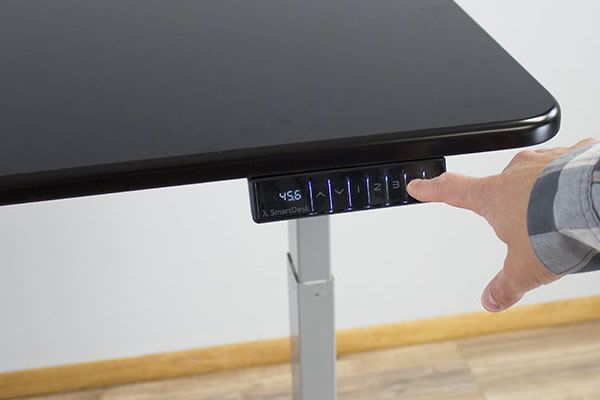
The current electronics pack for the Autonomous Desk comes from TiMotion. Founded in 2005, TiMotion is a manufacturer with the focus on electric linear technology products. We have actually had a fair amount of experience using TiMotion with our VertDesk v1 products. Unfortunately, our experience was not a good one and we decided to switch to the better quality LogicData electronics. Over our two year stint with TiMotion, we dealt with high failure rates in the field that left customers with desks that did not function properly.
The electronics pack for the Jarvis Desk comes from JieCang Linear Technology. These electronics are also manufactured in China. While both products quality is relatively similar, I would give a slight edge to the Jarvis Desk electronics here. This is due to the first hand experience with TiMotion and fewer known failures in the field from JieCang products. We are currently cycle testing all of the popular JieCang frames and will have a better understanding on these components over the course of the next few months.
Recently, I decided to pull apart the control boxes for all of the brands of standing desks I have reviewed. One thing I found interesting through this process was how similar the Chinese products were. There is a clear lack of attention to detail with the Chinese control boxes. Specifically, with an excessive amount of white epoxy used to hold wires in place and with the consistency of the toroid core coiling process. When looking at the TiMotion, they are the worst offenders of excessive white epoxy, and each product is below average with their toroid coiling.
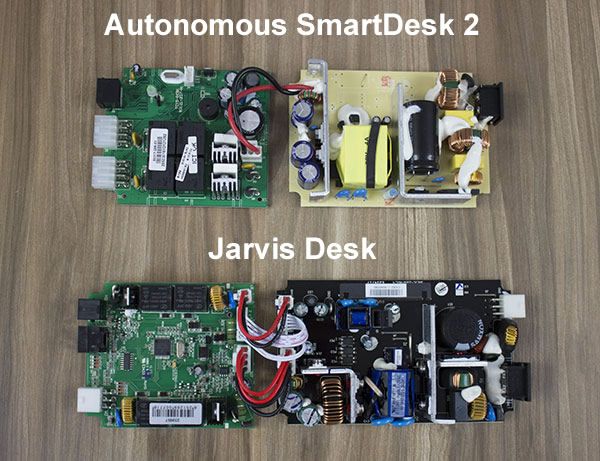
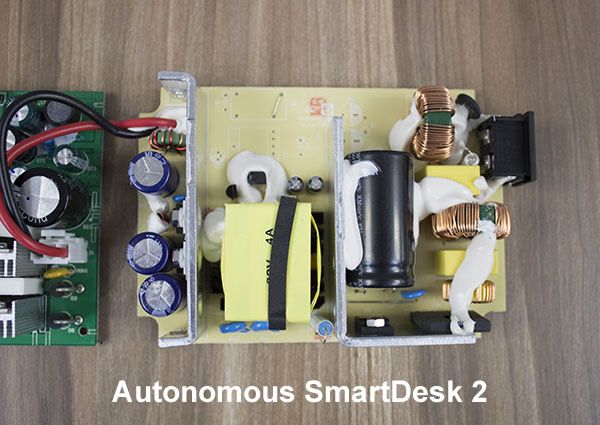
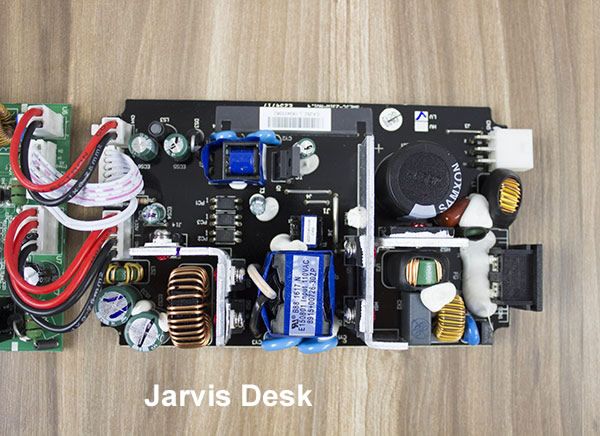
I have also included pictures from the LogicData Compact-Eco control box, found on the ModDesk Pro, to illustrate the clear differences. Seeing this made it fairly obvious to me why we have seen such better results switching to LogicData.


Weight Capacities and Testing
Motor Comparisons
After opening each of the desks columns, I was able to pull out the internal motors. While both motors were fairly similar, there were some clear differences. Each was strong based on the testing completed.
Taking a closer look at each motor, there were some obvious differences with the completed look of each. I would give TiMotion the edge, but this would only be based on look alone. They have done a good job fully enclosing their gear and worm drive. This helps to keep contaminants out of the motor, worm drive and gear. The Jarvis motor leaves the worm drive and gear exposed. There was also an excessive amount of grease on the gear and worm drive. So much that it had found its way onto the microchip that allowed the motor to communicate with the control box.
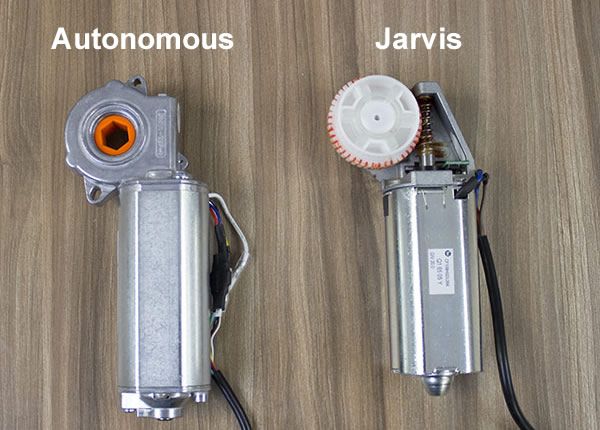
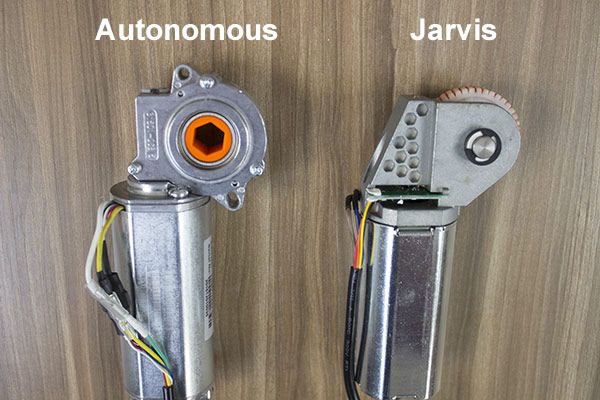
While the TiMotion motor looked better at first glance, my biggest concern was issues we’ve had using TiMotion motors in the past. Specifically, encoder issues with the motor that prevented it from functioning properly. Because the TiMotion motors are fully enclosed in the leg, a failure will require Autonomous to send a full leg replacement. Because Autonomous has switched their OEM twice in the first two years, there is a chance you will require an entirely new frame. Depending on your experience with the assembly process, this could potentially cause a huge headache.
Gear Comparisons
After pulling the gears out of both of the frames, the Autonomous Desk’s gear had a clear edge over the Jarvis Desk. The gear found within the Autonomous Desk had a very similar look to the two stage Ketterer gear found in the ModDesk pro. While it looked very similar to the ModDesk Pro’s gear, it wasn’t quite as smooth when manually sliding it back and forth. When compared to the Jarvis Desk, it was significantly better quality.

The Jarvis Desk came with a gear that, on its own, appeared to be well built. The more glaring issues I noticed were all of the plastic components used with the gear and the significant amounts of lubricant used on the gear. My first thought was that the plastic parts were load bearing and while the gears were strong, these plastic components were clear weak points. Secondly, the over lubrication could pose issues with efficiency of the gear. Overall, there was a lack of quality control with the gear and I wasn’t overly impressed.

On the other hand, I was a little bit surprised to find the gear that was inside the Autonomous Desk. Because of the price point, I would have expected equal or lower quality to the Jarvis Desk gears. While the Autonomous Desk gears aren’t on the same level as Ketterer or Linak, they are by far the best I have seen from Chinese made standing desks. I would be confident the gears would work well over the life cycle of the Autonomous Desk.
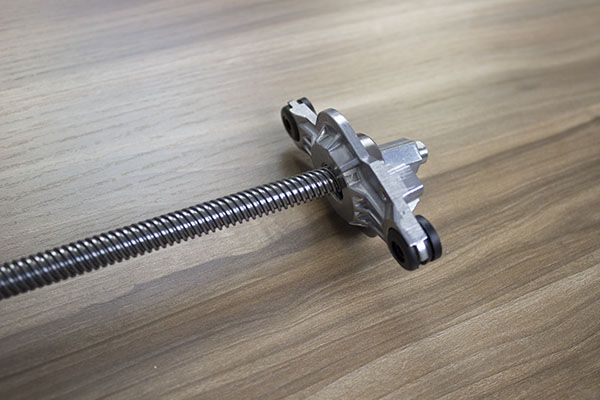
Glide Comparisons
Overall, both the Autonomous Desk and Jarvis Desk had less than stellar glide systems. This wasn’t much of a surprise, considering the amount of play I saw in each desks columns when doing stability testing.
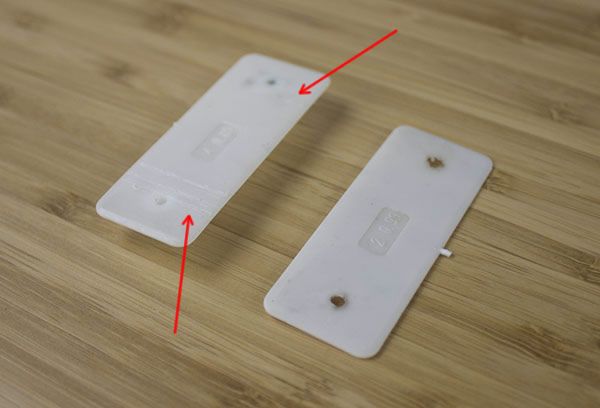
Having high quality glides are important for two major reasons. First, they provide stability by creating a proper fit between different size columns. Second, the plastic glides act as a lubricant, allowing the columns to slide smoothly when in transition. Over time, cheaper glides will wear down faster than higher quality alternatives. This will only exaggerate stability issues as the play within each of the columns increases.
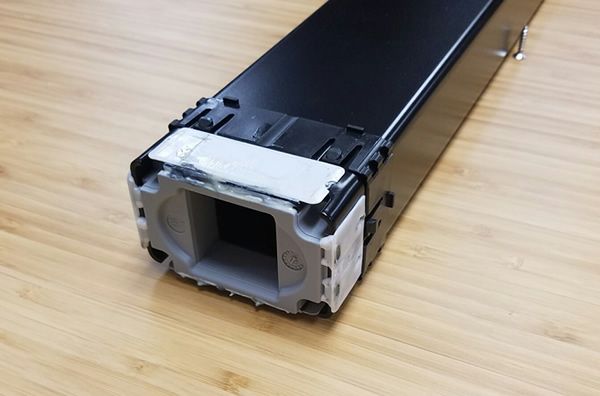
One of the first things you’ll notice in the pictures is how much less lubricant is used on the Autonomous Desk glides. While there is still more than the Linak column, it is much less than the JieCang columns used for the Jarvis Desk. By using less lubricant the Autonomous Desk is able to have a cleaner experience, with less build up on the outside of the columns. My only concern would be how well the lower quality plastic holds up without the additional lubricant. While higher quality plastics hold up well to high cycle counts, from what I have seen the cheaper plastics wear much quicker.

The Jarvis Desk had over lubrication issues similar to all of the other JieCang frames we have tested to date. Unlike the Uplift Desk, it didn’t have any dry spots on the glides. This was likely due to luck, more than any type of system in place. Within only 400 cycles performed on our first Jarvis Desk, contaminants had already started to build up within the lubricant and create awkward wearing on the glides. We learned after completing a full cycle test (8000 cycles) of the Jarvis Desk, this created serious binding issues within the columns. Because of this, the desk actually created a false positive with the anti-collision function and reverse course at 36”. Full details of our cycle testing will be released in a post soon.
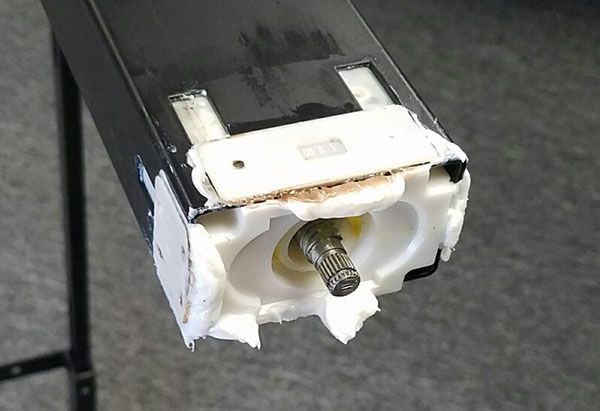
Frame and Foot Comparison
When looking at the design of the upper support frame and columns, they are very similar. The major differences being the feet of the desk frame. While the Autonomous Desk has well-built feet, the Jarvis Desk’s feet are built like a tank.
Each desk uses a traditional column set up, with the largest section on the bottom and the smallest on top. This is something that typically helps with front to back rocking motion. The paint on the Autonomous Desk columns was more of a high gloss, compared to the matte finish on the Jarvis Desk. Because of the over lubrication issues with the Jarvis Desk, after only a few cycles white residue began to build up on the columns.
Looking closer at each desks feet, the Autonomous Desk has more of a low profile design. The feet don’t stand out, but don’t look bad either. The column is set within the foot on the Autonomous Desk which allows it to gain additional range on the bottom end. The Jarvis Desk, on the other hand, has a higher profile design with their foot. The column is also set within the foot to allow it to gain maximum range on the bottom end. Overall, the Jarvis Desk’s foot stood out more because of the higher profile. Which option is better will likely depend on your specific tastes.
Lastly, looking underneath the foot, the threading used to mount the adjustable foot glide was worth a closer inspection. While this portion of the foot might not look like much, it plays an important role in the stability of the desk. After all, the desk is only as stable as the foundation it was built on. The Autonomous Desk had its steel foot plate tapped, creating only minimal threading to mount the glide. This meant the glide wasn’t able to create a nice solid connection and had some play. The Jarvis Desk used a welded nut inside of the foot, which created a much better connection. Overall, the Jarvis Desk’s glide was in place more securely with little play found unless you extended the glide outward (raising the desk).
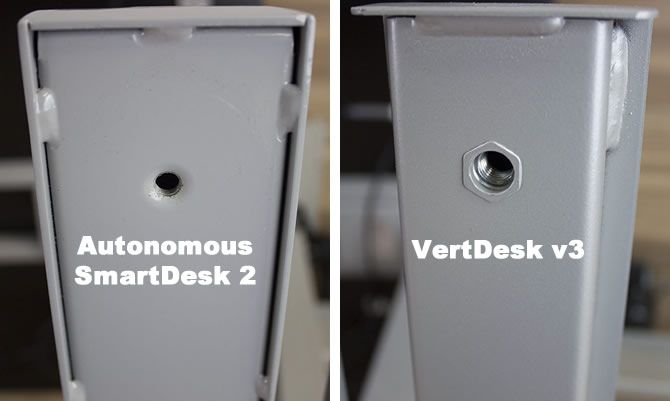
Stability of Each Desk
One of the most important aspects of any standing desk is stability. Having a standing desk that wobbles left to right, or rocks front to back, will create distractions throughout your day. These distractions are likely to reduce your overall work efficiency. See our top 6 reasons why standing desks wobble post for more information.
Front to Back: During the rocking test I found the Jarvis Desk to be more stable than the Autonomous Desk. There was a rocking motion that started as early as 32” on the Autonomous Desk. By 37” this rocking motion became bad. The Jarvis Desk on the other hand was solid below 44”. Once the desk moved beyond that point you could see the entire frame begin to bend forward and backward. Beyond 47”, the lack of overlap in the columns created a significant rocking motion.
Left to Right: The wobble test was opposite of the rocking test. The Jarvis Desk was the least stable here, with a left to right motion starting as early as 36”. Once the desk was raised beyond 40”, the wobble was bad and would impact your work. The Autonomous Desk was solid up to 40”, but then began to show signs of a slight wobble. Once the desk reached 42” the motion became bad.
Note: Regardless of the electric standing desk selected, it is important to always fully tighten the hardware. Without proper assembly, all standing desks will have stability issues when extended.
How Do They Operate
Both the Autonomous Desk and Jarvis Desk include a soft start mechanism for adjustment. While each includes collision avoidance, they weren’t very sensitive. Both desks were about average for sound while in motion at 59 decibels. Overall, I would say they both provide a nice fluid adjustment motion.
One thing we found during our Jarvis Desk review was that the desk stayed in motion for about .5 seconds after the button was released. This also happened with the other Jiecang products, including the Jarvis Desk by Fully. The Autonomous Desk stopped when the button was released.
The Autonomous Desk and Jarvis Desk each included a one touch memory system that allowed you to select a height and release the button. The desk will move to the preset height and stop.
Frame Colors
The Autonomous Desk is available in black, silver and white frame options. The Jarvis Desk is available in black, silver, white, alloy and red options.
Return Policy
| Autonomous Desk | Jarvis Desk |
| The Autonomous SmartDesk 2’s are returnable with no restocking fees for up to 30 days. Autonomous covers the return shipping cost. Must be returned in the original packaging in “like new” condition. | Jarvis frames do not have a restocking fee, but customers are charged for the return shipping charges. |
Warranty
| Autonomous Desk | Jarvis Desk |
| 5 warranty for electronics, which includes switch, motors and control box. The Autonomous desktops are covered for 1 year. | 15 years on Jarvis frame (components, mechanical parts, motors and electrical components. Desktops have a 5 year warranty. |
Bottom Line
Using both of these desks has given me an opportunity to understand the pros and cons of each. While the Autonomous Desk in the past had been 20-30% less expensive, the prices in 2022 are very similar. The Autonomous Desk features the fastest adjustment speed we have tested to date, but the speeds drop as the load is increased. The Jarvis Desk, on the other hand, offers a solid 350 lbs capacity with consistent adjustment speeds throughout all load testing. While I wouldn’t say the electronics are head and shoulders above the Autonomous desk, the 15 year warranty gives it an edge. I hope this comparison has helped give you an idea if the Autonomous Desk or Jarvis Desk would be a good fit for your needs.
Additional Standing Desk Resources
- The 4 Best Electric Standing Desks Under $800
- Top 6 Reasons Why Standing Desks Wobble
- VertDesk v3 vs. NewHeights XT: Which is better?
- GeekDesk v3 vs. VertDesk v3: Standing Desk Comparison
- Autonomous SmartDesk 2 vs. VertDesk v3: Which is the best?
- Uplift Desk vs. VertDesk v3: Which is better?
- The Uplift Desk vs. The Jarvis Standing Desk


